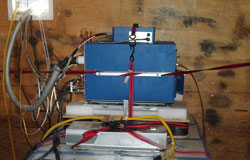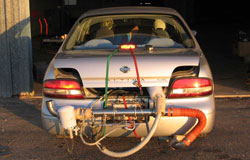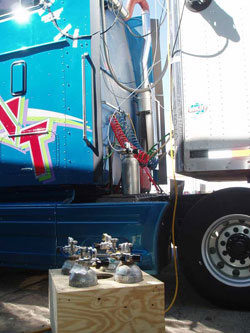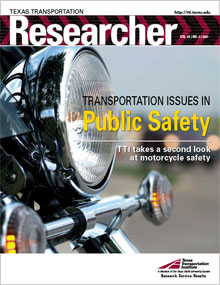TTI’s research yields new models for vehicle emission rates
Air pollution is a serious problem in the state of Texas. Children, the elderly, those with respiratory illness and those who work and exercise outdoors are at highest risk of developing medical complications—coughing, throat irritation and pain when breathing—often exacerbated by air pollution. An important source of air pollution is vehicle emissions, so accurate data about those pollutants is critical in understanding their impact and developing control strategies.
Researchers at the Texas Transportation Institute (TTI) recently completed a project aimed at measuring vehicle emissions from light-duty passenger cars, medium-duty trucks and 18-wheelers traveling upwards of 80 miles per hour. The project was sponsored by the Houston Advanced Research Center (HARC), Texas State Legislature and the Mid-Atlantic University Transportation Center (MAUTC).
“Current modeling provides emissions estimates for vehicles representing travel at only up to 65 miles per hour,” says TTI Director of the Center for Air Quality Studies Joe Zietsman. “Because of the trend of higher speed limits on Interstates in rural areas and the anticipated higher speed limits for proposed highways like the Trans-Texas Corridor, there was a need to better understand emissions at higher speeds.”
TTI’s Pecos Research and Testing Center was used the first week of March for the vehicle emissions testing phase of the project. The nine-mile, three-lane circular track that surrounds the facility was an ideal location for conducting the tests. A research team from TTI’s Center for Air Quality Studies equipped the vehicles with its recently acquired Portable Emissions Measurement System (PEMS) device to gather data during real driving conditions.




The PEMS device, shown in the top photos and bottom-right photo, allows researchers to gather emissions data during real driving conditions. (bottom-left) An 18-wheeler speeds around the nine-mile test track at the Pecos Research and Testing Facility.
“The PEMS unit has allowed us to conduct cutting-edge research by testing emissions during real driving conditions at higher speeds and has been used on six projects to date,” says Zietsman.
Using the data gathered from the vehicle testing, the research team was able to create reliable estimations of emissions for vehicles traveling at a high rate of speed. The findings from the study will enable transportation and air quality planners to more reliably assess impacts associated with high-speed operation already existing on freeways and tollways, as well as future facilities that will begin to appear in metropolitan transportation plans in the near future.
